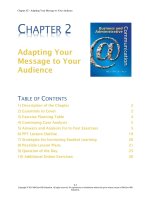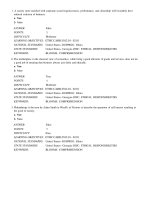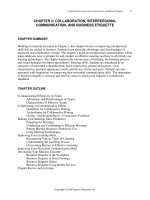Test bank and solution of BUsiness statistics a first course 7e by levine (2)
Bạn đang xem bản rút gọn của tài liệu. Xem và tải ngay bản đầy đủ của tài liệu tại đây (3.07 MB, 97 trang )
Solutions to End-of-Section and Chapter Review Problems
37
CHAPTER 2
2.1
(a)
(b)
2.2
(a)
(b)
2.3
(a)
(b)
Category
Frequency
A
13
B
28
C
9
Category “B” is the majority.
Percentage
26%
56
18
Table frequencies for all student responses
Student Major Categories
Gender A
C
M
Totals
Male 14
9
2
25
Female 6
6
3
15
Totals 20
15
5
40
Table percentages based on overall student responses
Student Major Categories
Gender A
C
M
Totals
Male 35.0% 22.5% 5.0% 62.5%
Female 15.0% 15.0% 7.5% 37.5%
Totals 50.0% 37.5% 12.5% 100.0%
Table based on row percentages
Student Major Categories
Gender A
C
M
Totals
Male 56.0% 36.0% 8.0% 100.0%
Female 40.0% 40.0% 20.0% 100.0%
Totals 50.0% 37.5% 12.5% 100.0%
Table based on column percentages
Student Major Categories
Gender A
C
M
Totals
Male
70.0% 60.0% 40.0% 62.5%
Female 30.0% 40.0% 60.0% 37.5%
Totals 100.0% 100.0% 100.0% 100.0%
You can conclude that Android smartphones have seen steady increase in market shares
while Blackberry and Other OS smartphones have seen steady decrease in market shares
since 2011. Android smartphones dominated the market in all those three years.
The iOS smartphones have overtaken Other OS smartphones and owned the second
largest market share since 2012. The Microsoft smartphones have arisen to the third
place in terms of market share in 2013 from the fifth place position in 2011 while the
Other OS smartphones have dropped from the second place in 2011 to the last place in
2013.
Copyright ©2016 Pearson Education, Inc.
38
2.4
Chapter 2: Organizing and Visualizing Variables
(a)
The percentage of complaints for each automaker:
Automaker
Frequency Percentage Cumulative Pct.
General Motors
551
18.91%
18.91%
Other
516
17.71%
36.62%
Nissan Motors Corporation
467
16.03%
52.64%
Ford Motor Company
440
15.10%
67.74%
Chrysler LLC
439
15.07%
82.81%
Toyota Motor Sales
332
11.39%
94.20%
American Honda
169
5.80%
100.00%
(b)
(c)
(d)
2.5
(a)
(b)
2.6
General Motors has the most complaints, followed by Other, Nissan Motors Corporation,
Ford Motor Company, Chryler LLC, Toyota Motor Sales and American Honda.
The percentage of complaints for each category:
Category
Frequency Percentage Cumulative Pct.
Powertrain
1148
42.82%
42.82%
Steering
397
14.81%
57.63%
Interior Electronics/Hardware
279
10.41%
68.03%
Fuel/Emission/Exhaust System
240
8.95%
76.99%
Airbags and Seatbelts
201
7.50%
84.48%
Body and Glass
182
6.79%
91.27%
Brakes
163
6.08%
97.35%
Tires and Wheels
71
2.65%
100.00%
Powertrain has the most complaints, followed by steering, interior electronics/hardware,
fuel/emission/exhaust system, airbags and seatbelts, body and glass, brakes, and, finally,
tires and wheels.
The percentage of values for each factor:
Most Important Factor Frequency Percentage Cumulative Pct.
Product
464
35.80%
35.80%
Leadership
400
30.86%
66.67%
Marketing
346
26.70%
93.36%
Technology
86
6.64%
100.00%
Product is the most influencing factor in successful start-ups, followed by Leardership,
Marketing and Technology.
(a)
Region
(b)
Oil Production
Percentage
(millions of barrels a day)
Iran
2.69
3.27%
Saudi Arabia
9.58 11.66%
Other OPEC countries
17.93 21.82%
Non-OPEC countries
51.99 63.26%
Total
82.19 100.00%
More than half the oil produced is from non-OPEC countries. About 22% is produced by
OPEC countries other than Iran and Saudi Arabia.
Copyright ©2016 Pearson Education, Inc.
Solutions to End-of-Section and Chapter Review Problems
39
2.7
(a)
The percentage of values for each response need:
Needs
Frequency Percentage Cumulative Pct.
Easier-to-use analytic tools
127
30.98%
30.98%
Improved ability to present and interpret data
123
30.00%
60.98%
Improved ability to predict impacts of my actions
49
11.95%
72.93%
Faster access to data
41
10.00%
82.93%
Improved relationships to the business line organizations
37
9.02%
91.95%
Improved ability to plan actions
33
8.05%
100.00%
(b)
“Easier-to-use analytic tools” is the most frequently mentioned need, followed by
“Improved ability to present and interpret data”, “Improved ability to predict impacts of
my actions”, “Faster access to data”, “Improved relationships to the business line
organizations” and “Improved ability to plan actions”.
2.8
(a)
Table of total percentages
ENJOY SHOPPING FOR
CLOTHING FOR YOURSELF
Male
Female
Total
22%
25%
47%
28%
25%
53%
50%
50%
100%
Yes
No
Total
Table of row percentages
ENJOY SHOPPING FOR
CLOTHING FOR YOURSELF
Table of column percentages
ENJOY SHOPPING FOR
CLOTHING FOR YOURSELF
(b)
GENDER
Male
Female
Total
46%
54%
100%
53%
47%
100%
50%
50%
100%
Yes
No
Total
Yes
No
Total
GENDER
GENDER
Male
Female
Total
44%
51%
47%
56%
49%
53%
100%
100%
100%
A higher percentage of females enjoy shopping for clothing for themselves.
Copyright ©2016 Pearson Education, Inc.
40
2.9
Chapter 2: Organizing and Visualizing Variables
(a)
Table of total percentages:
Project Owner's Backing History
Backing History No Backing History Total
26%
28%
54%
16%
30%
46%
42%
58%
100%
Project Outcomes
Successful
Not successful
Total
Table of row percentages:
Project Owner's Backing History
Backing History No Backing History Total
48%
52%
100%
35%
65%
100%
42%
58%
100%
Project Outcomes
Successful
Not successful
Total
(b)
(c)
Table of column percentages:
Project Owner's Backing History
Project Outcomes
Backing History No Backing History Total
Successful
62%
49%
54%
Not successful
38%
51%
46%
Total
100%
100%
100%
The column percentages is most informative for these data as they show that among those
owners with backing history, 62% are successful while only 49% are successful among
those with no backing history.
The percentage of success among owners with backing history is higher than those with
no backing history.
2.10
Social recommendations had very little impact on correct recall. Those who arrived at the link
from a recommendation had a correct recall of 73.07% as compared to those who arrived at the
link from browsing who had a correct recall of 67.96%.
2.11
Ordered array: 63 64 68 71 75 88 94
2.12
Ordered array: 73 78 78 78 85 88 91
2.13
(a)
(17 + 7) / 70 = 34.29% of small businesses pay less than 21% of the employee monthly
health-care premium.
2.14
(b)
(7 + 4) / 70 = 15.71% of small businesses pay between 21% and 75% of the employee
(c)
monthly health-care premium.
(35) / 70 = 50.00% of small businesses pay more than 75% of the employee monthly
health-care premium.
(a)
(b)
(c)
0 but less than 5 million, 5 million but less than 10 million, 10 million but less than 15
million, 15 million but less than 20 million, 20 million but less than 25 million, 25
million but less than 30 million.
5 million
2.5 million, 7.5 million, 12.5 million, 17.5 million, 22.5 million, and 27.5 million.
Copyright ©2016 Pearson Education, Inc.
Solutions to End-of-Section and Chapter Review Problems
2.15
(a)
(b)
2.16
41
Ordered array: Cost($) 203.06, 208.48, 212.16, 227.36, 240.04, 249.22, 262.40, 263.10,
266.40, 268.28, 271.74, 273.98, 280.98, 295.40, 308.18, 309.30, 319.10, 321.18,
321.63, 324.08, 336.05, 338.00, 344.92, 382.00, 395.20, 434.96, 456.60, 472.20,
542.00, 659.92,
PHStat output:
Bin Cell
Frequency Percentage Cumulative Pctage.
200 but less than 270
10 0.3333333
33.33%
270 but less than 340
12
0.4
73.33%
340 but less than 410
3
0.1
83.33%
410 but less than 480
3
0.1
93.33%
480 but less than 550
1 0.0333333
96.67%
550 but less than 620
0
0
96.67%
620 but less than 690
1 0.0333333
100.00%
(c)
The costs of attending a basketball game is concentrating around $305 for twelve
of the teams have costs between $270 and $340.
(a)
Electricity Costs
$80 to $99
$100 to $119
$120 to $139
$140 to $159
$160 to $179
$180 to $199
$200 to $219
Frequency
4
7
9
13
9
5
3
Percentage
8%
14
18
26
18
10
6
(b)
Electricity Costs Frequency Percentage Cumulative %
$99
4
8%
8%
$119
7
14%
22%
$139
9
18%
40%
$159
13
26%
66%
$179
9
18%
84%
$199
5
10%
94%
$219
3
6%
100%
(c)
The majority of utility charges are clustered between $120 and $180.
Copyright ©2016 Pearson Education, Inc.
42
2.17
Chapter 2: Organizing and Visualizing Variables
(a), (b) Annual Time Sitting in Traffic (hours)
Bin Cell
Frequency
15 but less than 20
1
20 but less than 25
4
25 but less than 30
4
30 but less than 35
2
35 but less than 40
7
40 but less than 45
3
45 but less than 50
4
50 but less than 55
2
55 but less than 60
1
60 but less than 65
1
65 but less than 70
0
70 but less than 75
2
(c)
(d)
2.18
Percentage
3.23%
12.90%
12.90%
6.45%
22.58%
9.68%
12.90%
6.45%
3.23%
3.23%
0.00%
6.45%
Cumulative Pctage.
3.23%
16.13%
29.03%
35.48%
58.06%
67.74%
80.65%
87.10%
90.32%
93.55%
93.55%
100.00%
Cost of Sitting in Traffic($)
Bin Cell
Frequency
Percentage
Cumulative Pctage.
300 but less than 450
4
12.90%
12.90%
450 but less than 600
6
19.35%
32.26%
600 but less than 750
6
19.35%
51.61%
750 but less than 900
5
16.13%
67.74%
900 but less than 1050
6
19.35%
87.10%
1050 but less than 1200
2
6.45%
93.55%
1200 but less than 1350
1
3.23%
96.77%
1350 but less than 1550
0
0.00%
96.77%
1550 but less than 1650
1
3.23%
100.00%
The annual time sitting in traffic is concentrated around 37.5 hours with a few spending
as much as around 72.5 hours.
The cost of sitting in traffic per year is concentrated around $675 with one costing as
much as $1,575.
(a), (b)
Bin Cell
695 but less than 705
705 but less than 715
715 but less than 725
715 but less than 735
735 but less than 745
745 but less than 755
755 but less than 765
765 but less than 775
775 but less than 785
795 but less than 795
(c)
Frequency
3
12
12
19
18
24
22
20
10
3
Percentage
2.10%
8.39%
8.39%
13.29%
12.59%
16.78%
15.38%
13.99%
6.99%
2.10%
The average credit scores are concentrated around 750.
Copyright ©2016 Pearson Education, Inc.
Cumulative Pctage.
2.10%
10.49%
18.88%
32.17%
44.76%
61.54%
76.92%
90.91%
97.90%
100.00%
Solutions to End-of-Section and Chapter Review Problems
2.19
43
(a), (b)
Bin
Frequency Percentage Cumulative %
-0.00350 but less than -0.00201
13
13.00%
13.00%
-0.00200 but less than -0.00051
26
26.00%
39.00%
-0.00050 but less than 0.00099
32
32.00%
71.00%
0.00100 but less than 0.00249
20
20.00%
91.00%
0.00250 but less than 0.00399
8
8.00%
99.00%
0.004 but less than 0.00549
1
1.00%
100.00%
(c)
2.20
Yes, the steel mill is doing a good job at meeting the requirement as there is only one
steel part out of a sample of 100 that is as much as 0.005 inches longer than the specified
requirement.
(a), (b)
Bin
(c)
2.21
Frequency
Percentage
Cumulative %
8.310 -- 8.329
3
6.12%
6.12%
8.330 -- 8.349
2
4.08%
10.20%
8.350 -- 8.369
1
2.04%
12.24%
8.370 -- 8.389
4
8.16%
20.41%
8.390 -- 8.409
4
8.16%
28.57%
8.410 -- 8.429
15
30.61%
59.18%
8.430 -- 8.449
7
14.29%
73.47%
8.450 -- 8.469
5
10.20%
83.67%
8.470 -- 8.489
5
10.20%
93.88%
8.490 -- 8.509
3
6.12%
100.00%
All the troughs will meet the company’s requirements of between 8.31 and 8.61 inches
wide.
(a),(b)
Strength
(c)
Frequency
Percentage
Cumulative Percentage
1500 -- 1549
1
3.33%
3.33%
1550 -- 1599
2
6.67%
10.00%
1600 -- 1649
2
6.67%
16.67%
1650 -- 1699
7
23.33%
40.00%
1700 -- 1749
5
16.67%
56.67%
1750 -- 1799
7
23.33%
80.00%
1800 -- 1849
3
10.00%
90.00%
1850 -- 1899
3
10.00%
100.00%
The strength of all the insulators meets the company’s requirement of at least 1500 lbs.
Copyright ©2016 Pearson Education, Inc.
44
2.22
Chapter 2: Organizing and Visualizing Variables
(a), (b) Manufacturer A:
Bin Cell
6,500 but less than 7,500
7,500 but less than 8,500
8,500 but less than 9,500
9,500 but less than 10,500
10,500 but less than 11,500
Frequency
3
5
20
9
3
Percentage
7.50%
12.50%
50.00%
22.50%
7.50%
Cumulative Pctage.
7.50%
20.00%
70.00%
92.50%
100.00%
Manufacturer B:
Bin Cell
7,500 but less than 8,500
9,500 but less than 9,500
9,500 but less than 10,500
10,500 but less than 11,500
11,500 but less than 12,500
2.23
Frequency
2
8
16
9
5
Percentage
5.00%
20.00%
40.00%
22.50%
12.50%
Cumulative Pctage.
5.00%
25.00%
65.00%
87.50%
100.00%
(c)
Manufacturer B produces bulbs with longer lives than Manufacturer A. The cumulative
percentage for Manufacturer B shows 65% of its bulbs lasted less than 10,500 hours,
contrasted with 70% of Manufacturer A’s bulbs, which lasted less than 9,500 hours. None
of Manufacturer A’s bulbs lasted more than 11,499 hours, but 12.5% of Manufacturer B’s
bulbs lasted between 11,500 and 12,499 hours. At the same time, 7.5% of Manufacturer
A’s bulbs lasted less than 7,500 hours, whereas all of Manufacturer B’s bulbs lasted at
least 7,500 hours
(a)
Amount of
Soft Drink
Frequency
Percentage
1.850 – 1.899
1
2%
1.900 – 1.949
5
10
1.950 – 1.999
18
36
2.000 – 2.049
19
38
2.050 – 2.099
6
12
2.100 – 2.149
1
2
Amount of
Frequency
Percentage
Soft Drink
Less Than
Less Than
1.899
1
2%
1.949
6
12
1.999
24
48
2.049
43
86
2.099
49
98
2.149
50
100
The amount of soft drink filled in the two liter bottles is most concentrated in two
intervals on either side of the two-liter mark, from 1.950 to 1.999 and from 2.000 to
2.049 liters. Almost three-fourths of the 50 bottles sampled contained between 1.950
liters and 2.049 liters.
(b)
Copyright ©2016 Pearson Education, Inc.
Solutions to End-of-Section and Chapter Review Problems
(a)
Percentages in decimals as proportions
Bar Chart
Improved transparency of financial
reporting and other corporate…
Most Needed Action
2.24
Improved regulation and oversight of
global systemic risk
Improved market trading rules on
transparency and frequency of trades
Improved enforcement of existing
laws and regulations
Improved corporate governance
practices
Improved auditing practices and
standards
0 0.05 0.1 0.15 0.2 0.25 0.3 0.35
%
Improved
transparency of
financial
reporting and
other corporate
disclosures
21%
Improved
regulation and
oversight of
global systemic
risk
29%
Pie Chart Improved
auditing
Improved
practices and
corporate
standards
governance
6%
practices
17%
Improved
market trading
rules on
transparency
and frequency
of trades
11%
Copyright ©2016 Pearson Education, Inc.
Improved
enforcement of
existing laws
and regulations
16%
45
46
Chapter 2: Organizing and Visualizing Variables
2.24
cont.
(a)
100%
90%
80%
70%
60%
50%
40%
30%
20%
10%
0%
Improved auditing
practices and standards
Improved enforcement
of existing laws and
regulations
Improved corporate
governance practices
Improved transparency
of financial reporting
and other corporate…
Improved regulation
and oversight of global
systemic risk
100%
90%
80%
70%
60%
50%
40%
30%
20%
10%
0%
Improved market
trading rules on
transparency and…
Pareto Chart
Most Needed Action
(b)
(c)
(a)
Bar Chart
Working, volunteering,
student clubs
Studying
Activity
2.25
The Pareto diagram is better than the pie chart to portray these data because it not
only sorts the frequencies in descending order, it also provides the cumulative polygon on
the same scale.
You can conclude that “improved regulation and oversight of global systemic risk”
accounts for the largest percentage (29%) of the most needed action to improve investor
trust and market integrity.
Socializing, recreation, other
Sleeping
Attending class/lab
0
10 20 30 40 50 60
%
Copyright ©2016 Pearson Education, Inc.
Solutions to End-of-Section and Chapter Review Problems
2.25
cont.
47
(a)
Working,
volunteering,
student clubs
9%
Studying
7%
Pie Chart
Attending
class/lab
9%
Sleeping
24%
Socializing,
recreating,
other
51%
(b)
(c)
The Pareto diagram is better than the pie chart or the bar chart because it not only sorts
the frequencies in descending order, it also provides the cumulative polygon on the same
scale.
From the Pareto diagram, it is obvious that slightly more than 50% of them were
socializing, recreating or performing other activities.
Copyright ©2016 Pearson Education, Inc.
48
2.26
Chapter 2: Organizing and Visualizing Variables
(a)
Pareto Chart
100%
100%
90%
90%
80%
80%
70%
70%
60%
60%
50%
50%
40%
40%
30%
30%
20%
20%
10%
10%
0%
0%
Coal
(b)
(c)
Natural gas
Nuclear
Hydro and
power
renewables
Source of Electricity
Other
Eighty-five percent of power is derived from coal, natural gas, or nuclear power.
Pie Chart
Nuclear power
19%
Other
2%
Coal
39%
Natural gas
27%
(d)
Hydro and
renewables
13%
The Pareto diagram is better than the pie chart because it not only sorts the frequencies in
descending order, it also provides the cumulative polygon on the same scale.
Copyright ©2016 Pearson Education, Inc.
Solutions to End-of-Section and Chapter Review Problems
2.27
49
(a)
(b)
The bar chart is more suitable if the purpose is to compare the categories. The pie chart
is more suitable if the main objective is to investigate the portion of the whole that is in a
particular category. *
* Note: This is one of the many possible solutions for the question.
Copyright ©2016 Pearson Education, Inc.
2.27
cont.
Chapter 2: Organizing and Visualizing Variables
(c)
(d)
2.28
The “vital few” reasons for the categories of complaints are “powertrain”, “steering”, and
“interior electronics/hardware” which account for more than 68% of the complaints. The
remaining reasons are the “trivial many” which make up less than 32% of the complaints.
(a)
Bar Chart
Wet cleaning
Water heating
Type of Use Percentage
50
Refrigeration
Other
Lighting
Heating
Electronics
Cooling
Cooking
0
0.05
0.1
0.15
Copyright ©2016 Pearson Education, Inc.
0.2
0.25
Solutions to End-of-Section and Chapter Review Problems
(a)
Pie Chart
Wet cleaning Cooking
Water heating
2%
3%
10%
Cooling
15%
Refrigeration
10%
Electronics
9%
Heating
15%
Other
23%
Lighting
13%
Pareto Chart
100%
90%
80%
70%
60%
50%
40%
30%
20%
10%
0%
Cooking
Wet cleaning
Electronics
Water heating
Refrigeration
Lighting
Heating
Cooling
100%
90%
80%
70%
60%
50%
40%
30%
20%
10%
0%
Other
2.28
cont.
51
Type of Use Percentage
(b)
(c)
The Pareto diagram is better than the pie chart and bar chart because it not only sorts the
frequencies in descending order; it also provides the cumulative polygon on the same
scale.
Other, cooling, heating and lighting accounted for 66% of the residential electricity
consumption in the United States.
Copyright ©2016 Pearson Education, Inc.
52
2.29
Chapter 2: Organizing and Visualizing Variables
(a)
(b)
The highest percentage of needs for employer success with human resource metrics and
reports comes from “easier-to-use analytic tools” at 30.98%, followed by “improved
ability to present and interpret data” at 30%, “improved ability to predict impacts of my
actions” at 11.95%, “faster access to data” at 10%, “improved relationships to the
business line organizations” at 9.02% and “improved ability to plan actions” at 8.05%.
Copyright ©2016 Pearson Education, Inc.
Solutions to End-of-Section and Chapter Review Problems
2.30
(a)
(b)
2.31
53
A higher percentage of females enjoy shopping for clothing.
(a)
Project Owner’s Backing
History
Side-by-side Bar Chart
No Backing History
Not successful
Successful
Backing History
0
5000
10000
15000
20000
25000
Project Outcome
(b)
2.32
The percentage of success among owners with backing history is higher than those with
no backing history.
(a)
Side-by-side Bar Chart
91
Browsing
193
No
407
0
(b)
Yes
150
Recommendation
100
200
300
400
500
Social recommendations had very little impact on correct recall.
Copyright ©2016 Pearson Education, Inc.
54
Chapter 2: Organizing and Visualizing Variables
2.33
Stem-and-leaf of Finance Scores
5
34
6
9
7
4
9
38
2.34
Ordered array: 50 74 74 76 81 89 92
2.35
(a)
(b)
(c)
(d)
2.36
Ordered array: 9.1 9.4 9.7 10.0 10.2 10.2 10.3 10.8 11.1 11.2
11.5 11.5 11.6 11.6 11.7 11.7 11.7 12.2 12.2 12.3
12.4 12.8 12.9 13.0 13.2
The stem-and-leaf display conveys more information than the ordered array. We can
more readily determine the arrangement of the data from the stem-and-leaf display than
we can from the ordered array. We can also obtain a sense of the distribution of the data
from the stem-and-leaf display.
The most likely gasoline purchase is between 11 and 11.7 gallons.
Yes, the third row is the most frequently occurring stem in the display and it is located in the
center of the distribution.
(a)
Stem-and-Leaf Display
Stem unit:100
(b)
2.37
(a)
Statistics
2 0113456677778
Sample Size
30
3 01122224448
Mean
326.2640
4 0367
Median
308.7400
5 4
Std. Deviation 102.7341
6 6
Minimum
203.0600
Maximum
659.9200
The costs are concentrated around $200 and $300.
Ordered array: 1.5, 3.2, 4.6, 7.1, 8.9, 9.0, 9.4, 9.9, 10.0, 10.1, 10.8, 11.5, 11.7, 11.8, 13.8,
14.0, 14.0, 16.1, 17.7, 26.3, 31.2, 32.5, 74.5, 91.6, 113.3, 127.4
Copyright ©2016 Pearson Education, Inc.
Solutions to End-of-Section and Chapter Review Problems
2.37
cont.
55
(b)
Stem-and-Leaf Display
Stemunit 10
Statistics
Sample Size
26
Mean
26.61154
Median
11.75
Std. Deviation 34.42669
Minimum
1.5
Maximum
127.4
(c)
(d)
(a)
Histogram
14
12
Frequency
2.38
0 2357999
1 000122244468
26
3 13
4
5
6
75
8
92
10
11 3
12 7
The stem-and-leaf display conveys more information than the ordered array. We can
more readily determine the arrangement of the data from the stem-and-leaf display than
we can from the ordered array. We can also obtain a sense of the distribution of the data
from the stem-and-leaf display.
The amount of caffeine in energy drinks is concentrated around 1.0 mg/oz.
10
8
6
4
2
0
90
110
130
150
170
190
210
Midpoints
Copyright ©2016 Pearson Education, Inc.
56
2.38
cont.
Chapter 2: Organizing and Visualizing Variables
(a)
Percentage Polygon
30%
25%
20%
15%
10%
5%
0%
70
90
110
130
150
170
190
210
230
(b)
Cumulative Percentage Polygon
100%
90%
80%
70%
60%
50%
40%
30%
20%
10%
0%
79
(c)
99
119
139
159
179
199
219
239
The majority of utility charges are clustered between $120 and $180.
2.39
The costs of attending a baseball game is concentrating around $200. There are a few outliers in
the right tail with two teams having a cost higher than $320.
2.40
Property taxes seem concentrated between $1,000 and $1,500 and also between $500 and $1,000
per capita. There were more states with property taxes per capita below $1,500 than above $1,500.
Copyright ©2016 Pearson Education, Inc.
Solutions to End-of-Section and Chapter Review Problems
2.41
(a)
(b)
Copyright ©2016 Pearson Education, Inc.
57
58
2.41
cont.
Chapter 2: Organizing and Visualizing Variables
(b)
(c)
(d)
2.42
The annual time sitting in traffic is concentrated around 37.5 hours with a few spending
as much as around 72.5 hours.
The cost of sitting in traffic per year is concentrated around $675 with one costing as
much as $1,575.
(a)
Copyright ©2016 Pearson Education, Inc.
Solutions to End-of-Section and Chapter Review Problems
2.42
cont.
(b)
(c)
2.43
59
The average credit scores are concentrated around 750.
(a)
(b)
Yes, the steel mill is doing a good job at meeting the requirement as there is only one
steel part out of a sample of 100 that is as much as 0.005 inches longer than the specified
requirement.
Copyright ©2016 Pearson Education, Inc.
60
2.44
Chapter 2: Organizing and Visualizing Variables
(a)
Percentage Polygon
35%
30%
25%
20%
15%
10%
5%
0%
--- 8.32 8.34 8.36 8.38 8.4 8.42 8.44 8.46 8.48 8.5 8.52
(b)
(c)
All the troughs will meet the company’s requirements of between 8.31 and 8.61 inches
wide.
Copyright ©2016 Pearson Education, Inc.
Solutions to End-of-Section and Chapter Review Problems
(a)
%Histogram
25.00%
20.00%
15.00%
10.00%
5.00%
0.00%
1525 1575 1625 1675 1725 1775 1825 1875
Midpoints
Percentage Polygon
25%
20%
15%
10%
5%
1925
1875
1825
1775
1725
1675
1625
1575
1525
1475
0%
(b)
Cumulative Percentage Polygon
100%
90%
80%
70%
60%
50%
40%
30%
20%
10%
(c)
1949
1899
1849
1799
1749
1699
1649
1599
1549
1499
0%
1449
2.45
The strength of all the insulators meets the company’s requirement of at least 1500 lbs.
Copyright ©2016 Pearson Education, Inc.
61









